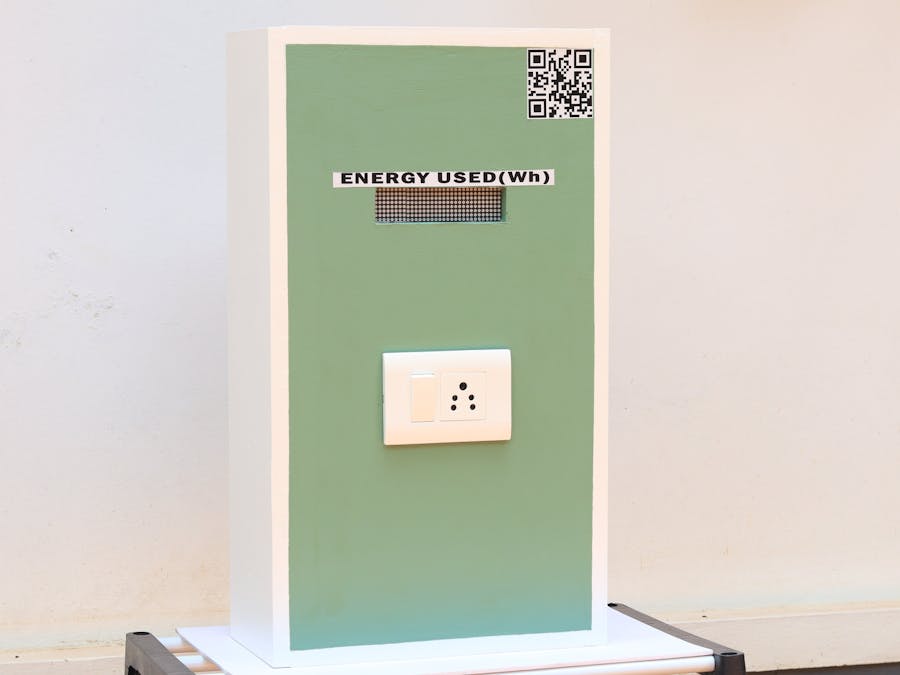In today's world, where taking care of our environment is a top priority, electric vehicles (EVs) have emerged as a vital solution for a cleaner future. They represent a significant change in how we think about transportation, aiming to reduce the environmental impact caused by traditional gas-powered vehicles. Despite the progress in EV technology, there's a big challenge – a lack of reliable charging spots in remote areas. Without proper infrastructure, it's tough for people with electric vehicles to travel long distances confidently.
Understanding the crucial role of EVs in fighting climate change, and addressing these challenges becomes crucial. That's where the Blues-powered Smart Charging Station comes in. It's not just a solution for immediate charging needs in remote places but a leap forward in making electric transportation practical and convenient for more people, bringing us closer to a greener future.
At its core, the Blues-powered Smart Charging Station addresses the critical need for reliable EV charging infrastructure in remote areas. By harnessing Blues technology, this innovative solution offers seamless connectivity and efficient power management, ensuring consistent and accessible charging for EV owners wherever they may be.
In this exploration of the Blues-powered Smart Charging Station, we'll uncover how it can change the game for EV charging in remote areas. As we go through this technological breakthrough, we'll witness not only the solution to a big problem but also the empowerment of electric vehicle owners, speeding up our journey to a more sustainable and eco-friendly future.
Benefits of the Blues-powered Smart Charging Stations:1. Enhanced EV Accessibility: By offering convenient charging options in remote areas, these stations encourage EV adoption and alleviate range anxiety among users.
2. Grid-Independent Operation: The stations operate independently of physical wiring or traditional electricity grids, making them suitable for installation in even the most remote locations. Moreover, they are solar-powered, further reducing reliance on conventional energy sources and enhancing sustainability.
3. User-Friendly App Interface: With a mobile app interface, users can easily access, manage, and pay for charging sessions, enhancing convenience and usability.
4. Scalable Network: Leveraging the Blues network, these stations can be seamlessly expanded across multiple remote locations, facilitating the growth of the charging network as demand increases.
5. Real-Time Monitoring and Management: Through the cloud platform, operators gain access to valuable data insights, enabling them to optimize charging efficiency and manage station performance in real time, ensuring reliable service for EV owners.
Role of Blues in this system- FWA (Fixed Wireless Access): Offering high-bandwidth and low-latency connectivity, even in remote areas, FWA facilitates seamless data transmission between the Notecard, Notehub, and Web interface, ensuring efficient communication channels.
- Secure Communication: With Blues technology at its core, the system guarantees secure data transmission and robust user authentication, safeguarding user privacy and financial information against potential threats.
1. Arrival and Wi-Fi Connection: Users arrive at the Blues-powered Smart Charging Station and connect their mobile devices to the station's Wi-Fi network.
2. QR Code Scanning: With a secure Wi-Fi connection established, users scan the unique QR Code on the charging station using the dedicated mobile app.
3. Local Host Redirection: The scanned QR Code redirects users to a local host server associated with the charging station, ensuring a seamless transition.
4. Authentication and Web Login: Users authenticate their identity on the local host server, gaining access to a personalized web page through the station's Wi-Fi.
5. Charging Initiation: On the web page, users press the "Start Charging" button to initiate the charging process.
6. Charging Control: Users can stop the charging process at any time by pressing the "Stop Charging" button on the web page.
7. User Departure: After charging or stopping the process, users can log out, ensuring a secure disconnection from the charging station's Wi-Fi.
This simplified process gives users direct control over their charging sessions, allowing them to stop the process whenever they choose. After completion, users can easily log out, ensuring a secure and straightforward departure from the Blues-powered Smart Charging Station's web interface.
Additionally, a solar panel, along with a battery, will be available to charge the electric vehicle, further enhancing the station's sustainability and energy efficiency.
Data Flow Diagram1)Notecard& NoteCarrier
The cellular IoT device from Blues serves as the cornerstone for communication and data transfer in this project. It seamlessly connects to the cloud, providing real-time updates without the need for subscriptions or cellular plans, thus ensuring effortless global connectivity.
What sets this device apart is its ease of programming using JSON, coupled with its low power consumption. Supporting both I2C and UART for sending JSON commands adds to its versatility.
Notably, Blues offers a range of Notecard options tailored to different regions and requirements. For this project, the Notecard cellular global version has been selected, offering a robust solution for our needs.
Notecards cannot function independently and require a compatible Notecarrier to house them. Blues offers a variety of Notecarriers, each with unique features. For this project, Notecarrier A was chosen.
Given that my country does not support embedded SIMs, an external SIM card was used to establish a connection with the Notehub.
For a quick start with the Notecard and Notehub follow this tutorial.
2) XIAO ESP32C3
The XIAO ESP32C3 development board, renowned for its compact size, serves as the central component in the charging station project. Leveraging the power of the ESP32 chipset, it enables seamless Wi-Fi connectivity, facilitating communication between the charging station and users' mobile devices. Additionally, with built-in Bluetooth support and compatibility with various peripherals, the XIAO ESP32 board offers flexibility for future expansion and customization of the charging station's features.
3)MAX7219 LED Dot Matrix 4-In-1 Display
The 8x8 dot matrix LED module features 64 individual LEDs arranged in an 8x8 grid, and is used for displaying energy usage metrics during device charging. It is driven by the MAX7219 driver chip, simplifying control and enabling efficient interfacing with the LED matrix. With its multiplexing capability, multiple modules can be cascaded together, expanding display options while conserving resources. This versatile module, known for its low power consumption and clear visibility, enhances user interaction and facilitates intuitive feedback in the charging station project.
4)ZMPT101B Voltage Sensor Module
The ZMPT101B Voltage Sensor is employed to gauge the voltage from the AC line in the charging station setup. Utilizing a ZMPT101B voltage transformer, this sensor module generates an output that mirrors the input current, maintaining a 1:1 ratio between input and output currents. With its output directly readable using an ADC, the sensor facilitates the calculation of AC voltage, enabling accurate voltage measurement within the system.
5)Current Sensor
The DF Robot Non-Invasive AC Sensor Split Core Current Transformer, capable of handling currents up to 20A, is utilized in the system. This sensor enables precise measurement of electric current without the need for direct contact, ensuring safety and ease of installation. Its high precision and split-core design facilitate accurate monitoring and control of charging processes, enhancing the efficiency and reliability of our charging station for electric vehicles.
6)Relay module
The SRD-05VDC-SL-C relay is used for controlling the charging process. Operating on direct current, it features a single-pole, double-throw (SPDT) relay with a common terminal, normally open (NO) terminal, and normally closed (NC) terminal.
7)Power supply
The power supply which we are using is the HLK-20M05 from Hi-Link. This AC-to-DC converter has a 5V output at a maximum current of 5A (total 20 Watts).
SoftwareIntegration of Firebase for Data Storage and Management
In the architecture of the Charging Station, the Firebase Realtime Database serves as the central component of the cloud infrastructure, offering a scalable NoSQL database solution specifically designed for real-time data storage and synchronization. Tailored to manage JSON-formatted data, this database facilitates instantaneous updates and synchronization across various platforms and devices, which is particularly critical for IoT applications leveraging Blues Notecards.
Firebase's real-time capabilities empower immediate data propagation to connected devices and applications, supporting scenarios where live data updates are essential. Furthermore, its offline persistence feature ensures data availability even in the absence of an internet connection. This serverless architecture eliminates the need for managing servers, providing seamless integration opportunities for IoT devices. Through Firebase's RESTful API, IoT devices can efficiently store and retrieve data, enhancing overall functionality and performance.
After setting up the Firebase Realtime Database, obtain the Firebase URL, which serves as the communication link between Firebase and Notehub. This URL facilitates seamless interaction, allowing Notehub to access and utilize the data stored within the Firebase Realtime Database using REST APIs.
Notehub Integration: Facilitating Data Routing
In the framework of the Blues ecosystem, Notehub assumes a pivotal role, facilitating seamless communication between IoT devices powered by Blues Notecards and various cloud services. This centralized platform serves as a hub for managing device connectivity, data processing, and routing configurations with efficiency and precision.
Through the user-friendly interface of Notehub, stakeholders can provision and oversee Notecards, establishing routes to direct data streams to specific cloud endpoints. Each transmission is secured by robust authentication measures, ensuring the integrity and confidentiality of the data in transit.
Among its key features, Notehub offers the capability to preprocess data before transmission, enabling customization of data formats to meet the requirements of destination systems. Additionally, stringent security protocols are in place to safeguard data exchanges, employing encryption mechanisms for enhanced protection.
This versatile platform supports seamless integration with a variety of cloud services, facilitating diverse IoT deployments and scenarios such as remote monitoring and data analysis. For example, data from Notecards can be seamlessly routed to Firebase endpoints for storage, analysis, or visualization purposes.
To initiate the integration process, users can refer to a comprehensive setup tutorial. Once devices are successfully connected and data streams are established, configuring a route to Firebase is straightforward:
1. Navigate to the Routes Section:
Access the Routes section within the Notehub interface.
2. Create a New Route:
Initiate the route creation process and select "Proxy for Notecard Web Requests" to define the route type.
3. Configure Route Details:
Enter the necessary details, including the Firebase Reference URL and a suitable alias for the route.
You can see the routes when apply changes like this.
Web Dashboard with Local Web Server Handling
The customizable dashboard, built using HTML, CSS, and JavaScript, is seamlessly managed by a local web server. This setup ensures smooth handling and accessibility of the dashboard, providing users with a reliable interface for monitoring and managing data stored in the Firebase Realtime Database.
For the enclosure making, we utilized 3/4 inch MDF wood, crafting it into a rectangular shape to house the charging station.
We began by creating the outer shell and securing the pieces together using L clamps, before assembling the front and back portions.
Once the assembly was complete, we applied a coat of paint featuring a vibrant green and ivory colour combination, giving the enclosure an attractive and distinctive appearance.
Initially, the three-pin plug was fastened to the charging station.
Then we started placing electronic components. The components are connected with the jumper cables through a small breadboard.
The Hi-link power supply is placed on the perf board for the easy connection of AC input.
The whole AC wires have been attached to this three-pin Smart plug.
Finally, the stickers of QR codes and energy-used tags have been added to the device.
In the upcoming update for the project, solar panels and batteries will be integrated, elevating the functionality and sustainability of the charging station to new heights. By harnessing solar energy, the reliance on traditional power sources will be reduced, making the charging station more environmentally friendly and energy-efficient. Additionally, the addition of batteries will enable energy storage, ensuring uninterrupted charging services even during periods of low sunlight or grid outages. With these enhancements, the charging station will provide convenient and reliable charging solutions for electric vehicles while contributing to a greener and more sustainable future for transportation



















Comments
Please log in or sign up to comment.